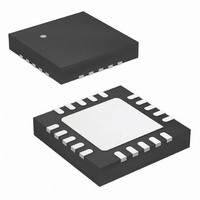ATTINY24-15MZ Atmel, ATTINY24-15MZ Datasheet - Page 130

ATTINY24-15MZ
Manufacturer Part Number
ATTINY24-15MZ
Description
MCU AVR 2K FLASH 15MHZ 20-QFN
Manufacturer
Atmel
Series
AVR® ATtinyr
Datasheet
1.ATTINY24-15MZ.pdf
(225 pages)
Specifications of ATTINY24-15MZ
Package / Case
20-QFN Exposed Pad
Voltage - Supply (vcc/vdd)
2.7 V ~ 5.5 V
Operating Temperature
-40°C ~ 125°C
Speed
16MHz
Number Of I /o
12
Eeprom Size
128 x 8
Core Processor
AVR
Program Memory Type
FLASH
Ram Size
128 x 8
Program Memory Size
2KB (2K x 8)
Data Converters
A/D 8x10b
Oscillator Type
Internal
Peripherals
Brown-out Detect/Reset, POR, PWM, WDT
Connectivity
USI
Core Size
8-Bit
Cpu Family
ATtiny
Device Core
AVR
Device Core Size
8b
Frequency (max)
16MHz
Interface Type
SPI/UART
Total Internal Ram Size
128Byte
# I/os (max)
12
Number Of Timers - General Purpose
2
Operating Supply Voltage (typ)
3.3/5V
Operating Supply Voltage (max)
5.5V
Operating Supply Voltage (min)
2.7V
On-chip Adc
8-chx10-bit
Instruction Set Architecture
RISC
Operating Temp Range
-40C to 125C
Operating Temperature Classification
Automotive
Mounting
Surface Mount
Pin Count
20
Package Type
QFN EP
Lead Free Status / RoHS Status
Lead free / RoHS Compliant
- Current page: 130 of 225
- Download datasheet (4Mb)
16.5.4
130
Atmel ATtiny24/44/84 [Preliminary]
USICR – USI Control Register
An interrupt will be generated when the flag is set while the USISIE bit in USICR and the
global interrupt enable flag are set. The flag will only be cleared by writing a logical one to the
USISIF bit. Clearing this bit will release the start detection hold of USCL in two-wire mode. A
start condition interrupt will wakeup the processor from all sleep modes.
• Bit 6 – USIOIF: Counter Overflow Interrupt Flag
This flag is set (one) when the 4-bit counter overflows (i.e., at the transition from 15 to 0). An
interrupt will be generated when the flag is set while the USIOIE bit in USICR and the global
interrupt enable flag are set. The flag is cleared if a logical one is written to the USIOIF bit or
by reading the USIBR register. Clearing this bit will release the counter overflow hold of SCL in
two-wire mode.
A counter overflow interrupt will wakeup the processor from Idle sleep mode.
• Bit 5 – USIPF: Stop Condition Flag
When two-wire mode is selected, the USIPF flag is set (one) when a stop condition is
detected. The flag is cleared by writing a logical one to this bit. Note that this is not an interrupt
flag. This signal is useful when implementing two-wire bus master arbitration.
• Bit 4 – USIDC: Data Output Collision
This bit is logical one when bit 7 in the Shift Register differs from the physical pin value. The
flag is only valid when Two-wire mode is used. This signal is useful when implementing
Two-wire bus master arbitration.
• Bits 3..0 – USICNT3..0: Counter Value
These bits reflect the current 4-bit counter value. The 4-bit counter value can be read or writ-
ten directly by the CPU.
The 4-bit counter increments by one for each clock generated either by the external clock
edge detector, by a timer/counter 0 compare match, or by software using USICLK or USITC
strobe bits. The clock source depends on the setting of the USICS1..0 bits. For external clock
operation, a special feature is added that allows the clock to be generated by writing to the
USITC strobe bit. This feature is enabled by writing a logical one to the USICLK bit while set-
ting an external clock source (USICS1 = 1).
Note that even when no wire mode is selected (USIWM1..0 = 0), the external clock input
(USCK/SCL) can still be used by the counter.
The Control Register includes interrupt enable control, wire mode setting, Clock Select setting,
and clock strobe.
Bit
0x0D (0x2D)
Read/Write
Initial Value
USISIE
R/W
7
0
USIOIE
R/W
6
0
USIWM1
R/W
5
0
USIWM0
R/W
4
0
USICS1
R/W
3
0
USICS0
R/W
2
0
USICLK
W
1
0
USITC
7701D–AVR–09/10
W
0
0
USICR
Related parts for ATTINY24-15MZ
Image
Part Number
Description
Manufacturer
Datasheet
Request
R

Part Number:
Description:
Manufacturer:
Atmel Corporation
Datasheet:

Part Number:
Description:
Manufacturer:
Atmel Corporation
Datasheet:

Part Number:
Description:
IC MCU AVR 2K FLASH 20MHZ 20-QFN
Manufacturer:
Atmel
Datasheet:

Part Number:
Description:
IC MCU AVR 2K FLASH 20MHZ 14SOIC
Manufacturer:
Atmel
Datasheet:

Part Number:
Description:
IC MCU AVR 2K FLASH 20MHZ 14-DIP
Manufacturer:
Atmel
Datasheet:

Part Number:
Description:
MCU AVR 2KB FLASH 20MHZ 14SOIC
Manufacturer:
Atmel
Datasheet:

Part Number:
Description:
MCU AVR 2KB FLASH 20MHZ 20QFN
Manufacturer:
Atmel
Datasheet:

Part Number:
Description:
MCU AVR 2K FLASH 15MHZ 14-SOIC
Manufacturer:
Atmel
Datasheet:

Part Number:
Description:
DEV KIT FOR AVR/AVR32
Manufacturer:
Atmel
Datasheet:

Part Number:
Description:
INTERVAL AND WIPE/WASH WIPER CONTROL IC WITH DELAY
Manufacturer:
ATMEL Corporation
Datasheet:

Part Number:
Description:
Low-Voltage Voice-Switched IC for Hands-Free Operation
Manufacturer:
ATMEL Corporation
Datasheet:

Part Number:
Description:
MONOLITHIC INTEGRATED FEATUREPHONE CIRCUIT
Manufacturer:
ATMEL Corporation
Datasheet:










